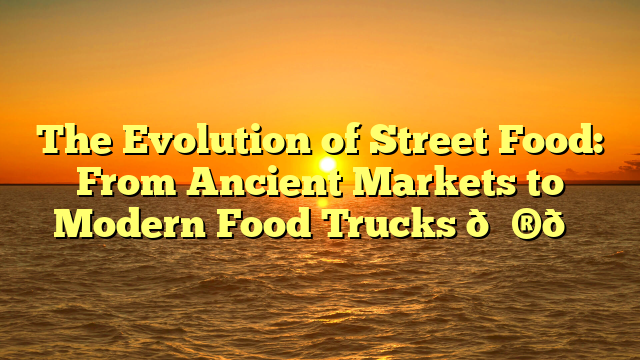Street food has been a part of human civilization for thousands of years, evolving from ancient markets to the vibrant food truck culture we see today. It represents the heart and soul of local cuisine, offering a quick, affordable, and delicious way to experience diverse flavors from around the world.
In this article, we’ll take a journey through the history, evolution, and cultural significance of street food, exploring how it has transformed from simple roadside stalls to gourmet mobile kitchens.
1. The Origins of Street Food: Ancient Beginnings 🏺🍢
Street food isn’t a modern concept—it has existed for millennia. Some of the earliest records of street food date back to Ancient Egypt, Greece, and Rome.
✔ Ancient Egypt ✔ Ancient Greece ✔ Ancient Rome – Many Romans relied on thermopolia, small street-side food stalls, for quick and affordable meals like stews and flatbreads.
These early street food vendors provided meals to travelers, workers, and the lower classes who couldn’t afford private kitchens, much like today’s food stalls serve people on the go.
2. Street Food in the Middle Ages: Markets and Bazaars 🏰🍲
During the Middle Ages, street food became a staple in bustling markets, town squares, and bazaars across Europe, Asia, and the Middle East.
✔ Asia ✔ Middle East ✔ Europe – Street vendors in England and France sold meat pies, roasted nuts, and fish, which were popular among both the wealthy and the working class.
By this time, street food wasn’t just for survival—it became a part of social and cultural traditions, shaping local cuisines and community interactions.
3. The Rise of Street Food in the Industrial Revolution 🚂🍟
The Industrial Revolution (18th–19th centuries) led to rapid urbanization, and with it, the need for fast, cheap, and filling meals for factory workers and city dwellers.
✔ United slot bonus new member ✔ Europe – The tradition of fish and chips ✔ Asia – Food carts and street stalls in countries like China, India, and Thailand adapted to the growing population by offering convenient, inexpensive meals.
Street food became a symbol of economic and cultural diversity, blending local and immigrant influences into the food scene.
4. The 20th Century: The Global Street Food Explosion 🌏🍜
By the 20th century, street food had spread across the world, with each region developing signature street dishes that became defining aspects of their cultures.
Iconic Street Foods from Around the World
✔ Mexico ✔ India ✔ China ✔ United States – The invention of food trucks led to the rise of hot dog stands, burger carts, and later gourmet street food trucks ✔ Middle East – Shawarma, falafel, and hummus wraps gained international popularity.
During this time, globalization and travel helped introduce people to new flavors and culinary experiences, making street food an essential part of tourism.
5. The Modern Era: The Rise of Food Trucks & Gourmet Street Food 🚚🍔
In the 21st century, street food culture has transformed once again—this time into a fusion of traditional flavors and modern innovation.
✔ The Food Truck Revolution – In cities like Los Angeles, New York, and London, food trucks offer gourmet versions of classic street food like Korean BBQ tacos, artisanal burgers, and sushi burritos ✔ Social Media Impact – Platforms like Instagram and TikTok have turned street food into a viral sensation, with people traveling across cities to try the latest food trends ✔ Healthier & Sustainable Options – Many modern street food vendors focus on organic, vegan, and locally sourced ingredients, catering to a new generation of health-conscious eaters.
Today, street food isn’t just about cheap, fast meals—it’s about culinary creativity, cultural exchange, and accessibility.
6. Why Street Food Matters: Culture, Economy, and Community 🍽️❤️
Street food is more than just a way to eat—it’s a reflection of history, community, and tradition.
✔ Cultural Identity – Street food represents the heritage and flavors ✔ Economic Growth – Street food businesses create jobs and provide affordable dining options ✔ Social Connection – Whether it’s sitting at a food cart in Bangkok or grabbing a taco in Mexico City, street food brings people from all walks of life together.
7. Conclusion: The Future of Street Food 🚀🍛
Street food has come a long way—from ancient markets to modern food trucks, it has evolved with time while staying true to its core purpose: serving delicious, accessible, and culturally rich food.
With the rise of technology, sustainability, and innovation, the future of street food is brighter than ever. As people continue to explore new flavors, street food will remain a beloved culinary experience across the world.
What’s the best street food you’ve ever tried? Let’s talk in the comments! 🌮🍜👇
The Evolution of Street Food: From Ancient Markets to Modern Food Trucks 🌮🚚










